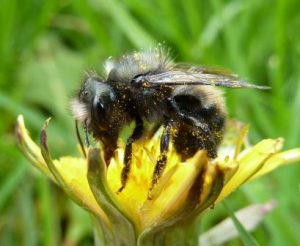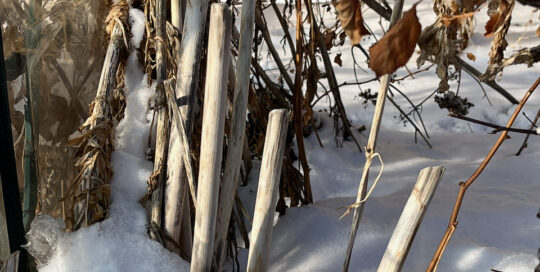Are Solitary Bees the Future of Pollination?
Views: 3541

In 1995 I noticed one honey bee all summer long in my gardens in Coram, Montana. It had been a rough winter, so I thought I needed to do my part and learn how to keep bees.
It was a comical start, but I eventually kept a hive or two for many years. When I met my husband he took it up to the next level, keeping up to ten hives and caring for them a lot more. We also harvested considerably more honey. I think the best year was spinning 900 pounds of honey from a half dozen hives when we lived on the west side of the mountains. That was impressive.
It’s not so great on the east side where it’s dry and windy. Last year we lost 3 hives in May because the colonies weren’t large enough to sustain the hive’s temperature during a cold snap. It becomes pricey to replace them, particularly later in the season. Plus, my husband moves them onto an alfalfa field, so they’re not even available to my gardens for pollination.
I thought, there has to be a better option than the little divas.
Mason Bees
Then I wondered about Mason (also called Blue Orchard) bees. I’ve heard of them, and have seen pictures of the nifty little houses in gardening magazines, but that’s the extent of my knowledge base. So I was thrilled when Dave Hunter, president of the Orchard Bee Association and owner of Crown Bee, was willing to talk to me about them and about our perilous pollination situation.
“The honey bee is failing fast,” he told me. “It’s going to be a national problem real soon. We have to get the backyard gardeners across North America moving as fast as possible.”
Mason bees are a solitary bee, and they’re not an anomaly compared to the honey bee. There are more solitary species than there are social bees, says Hunter.
Since they’re not defending a hive and pounds of precious honey, they’re also far gentler than honey bees. They’ll only sting under the most dire circumstance, and even then it’s about as potent as a mosquito bite.
“Every female is a queen. She can defend one little hole or go get nectar and pollen,” he says. “They’re just so cute.”
There are a number of native solitary bees that overlap when they are out and about, and vary on what they prefer for food sources. Some are very specific; others are far more general. Hunter recommends that people learn what bee belongs in their region for the greatest success.
Setting Up a Bee House
When setting up a bee house, Hunter steers people clear of the blocks of wood drilled with holes because it sets up an ideal situation for an ongoing problem with pollen mites and other pests.
Besides a small house (preferably with some sort of encasement, even as simple as a bucket, to keep out the weather), the bees need pollen, mud (This is very important! You might even need to dig them a little hole.), little or no pesticide use in the garden, knowledge of when to set them free or gather them and harvesting them in the fall.
Hunter says it’s best to put the bee house facing east at roughly head height, just so you can enjoy watching them.
I’m going to give them a try in the garden this year. A bee that is more efficient at pollination than the honey bee, which is also gentle, is appealing to me. And if my husband can keep 4 hives underneath the house, I’m sure he won’t mind if I keep a few cocoons in the refrigerator next year. In the meantime, I’m signing up for Dave’s “Bee-Mail” on his website (www.crownbees.com) to learn more about successfully raising them.
(The photo is used by permission from crownbees.com since I haven’t set up my own little bee house, yet.)
Meet Amy Grisak
Amy is a freelance author and photographer in Great Falls, MT who specializes in gardening, foods, and sustainable agriculture. She provides information on every kind…
Amy's Recent Posts

This Little Piggy is a Problem: Dealing with Feral Hogs








